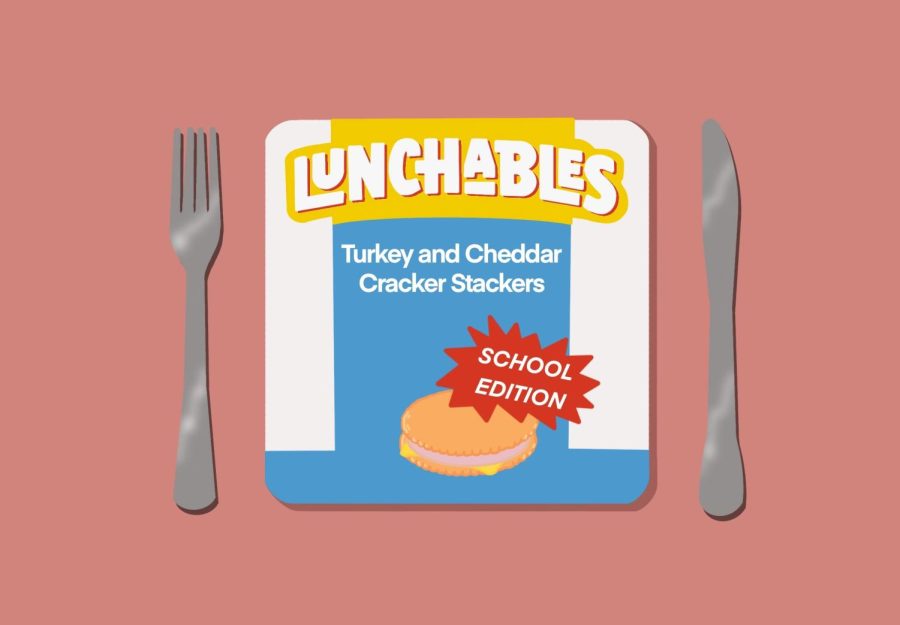Implementation of Lunchables meals is an insufficient solution to nutritional discrepancies
In the 2023-24 school year, two versions of Lunchables with “improved nutrition” will be offered by the National School Lunch Program, an organization that provides school lunches for over 30 million K-12 students in the United States. While the modified Lunchables meet the standards of the NSLP, they pose significant threats to the health of American children.
April 4, 2023
Lunchables, a brand of pre-made meals, will soon be served to students through school lunch programs. In February, Kraft Heinz executive vice president Carlos Abrams-Rivera announced that two new varieties of Lunchables with “improved nutrition” adhering to the standards of the National School Lunch Program had been developed and will be given to K-12 students in the United States starting in the fall.
Despite the many modifications to make Lunchables healthier, these ready-to-go meals do not provide a satisfactory solution to the growing nutritional discrepancies in American school lunches.
The modified Lunchables will only facilitate the rising health problems among American children. According to the Centers for Disease Control and Prevention (CDC), 9 in 10 children in the U.S. consume too much sodium each day, and 14.3 million children (19.7 percent) in the U.S. are affected by obesity. The Turkey and Cheddar Cracker Stackers, one of the modified school Lunchable options, contains 930 mg of sodium, more than half of the daily sodium limit for children ages 14 and under. According to the CDC, a high daily sodium intake can lead to an increased risk of heart disease, stroke and obesity.
Lunchables, even modified ones, contain many ultra-processed foods, packaged foods that have been manufactured with very few whole foods. Implementing ultra-processed foods such as Lunchables into school meals can have a negative effect on student’s health. The meats in Lunchables are especially concerning to health experts; the World Health Organization classifies processed meats as group one carcinogens, meaning that there is sufficient evidence that processed foods can cause cancer, specifically colorectal cancer. A 2023 study published in eClinicalMedicine found that ultra-processed foods also have an association with an increased risk of cancer, particularly ovarian cancer. In addition, the study found that consuming ultra-processed foods correlated with an increased risk for breast and ovarian cancer-related mortality. It would be healthier for students if fresh foods were included in school lunches as a substitute for processed foods like Lunchables.
Implementing Lunchables into daily lunches for students would only be beneficial to the Kraft Heinz company and not the students. For decades, big companies have plagued the cafeterias of K-12 schools, but their control over schools has increased since the pandemic. After schools began reopening in 2021, cafeterias faced staff shortages and struggled to provide lunches for students. According to the School Nutrition Association, almost 93 percent of school nutrition programs reported challenges with staff shortages. Schools were forced to choose between healthy foods they couldn’t afford and cheaper, unhealthy foods. As a result, schools became a target of large food companies such as Kraft Heinz and Tyson who profit from mass food sales. If Lunchables are included in school lunch menus under the National School Lunch Program, around 30 million students in the U.S. would have access to Lunchables every day, meaning that Kraft Heinz would profit.
Many companies view K-12 schools as a marketing opportunity for their food. One study found that from 2007 to 2012, 70 percent of elementary and middle school students in the U.S. experienced some form of food marketing. In some cases, schools have allowed food advertisements because of funding shortages. The marketing of food has been extremely influential; one study found that food commercials and marketing played a key role in developing brand attachment amongst children. Research has found that there is a strong correlation between food marketing, especially marketing of unhealthy foods, and childhood obesity. Implementing Lunchables as a daily meal for adolescents could have severe effects on their dietary choices, encouraging them to develop habits to consume similar foods that contain high amounts of sugar and sodium.
Additionally, serving unhealthy food such as Lunchables in school lunch programs would only further divide existing socioeconomic classes in the U.S. One study found that students consuming school lunches typically had a lower household income than students who weren’t exposed to school lunches. For many students, bringing lunches to school is unaffordable, meaning school-provided lunches are the only option. In the 2022-23 school year, students with a household income of $36,075 or less were eligible to receive free school-provided meals, and students with a household income of $51,338 or less were eligible to receive reduced-price meals. In 2020, 76.9 percent of school lunches provided by the National School Lunch Program were served for free or at a reduced price for eligible students. Students that cannot afford to bring lunches to school are already vulnerable to innutritious meals. Serving Lunchables in school would worsen nutritional disparities that are already prevalent among low-income populations in the U.S.
Due to staffing shortages in school cafeterias, Lunchables can be seen as beneficial as they require little food preparation or work from school staff. However, legislators should improve working conditions for cafeteria staff instead of implementing unhealthy school meals to fix the issue. From 2014 to 2019, the median weekly wage for K-12 cafeteria workers was $331 in comparison to the median weekly wage for the average U.S. worker, which was $790 per week. As a result of low wages, many cafeteria workers have been forced to find other employment opportunities. Therefore, U.S. legislators should raise wages for K-12 cafeteria workers to encourage adequate staffing in school cafeterias. Reducing staffing shortages would enable cafeteria workers to provide more nutritious meals for students as they would have more assistance from additional staff, meaning that the efficiency of Lunchables would no longer be useful for lunch programs.
While Lunchables may be efficient as they require little food preparation or work from school staff, they present an unhealthy solution to school meals. Lunchables are insufficient as they exacerbate the many health dangers children face in the U.S. Lunchables may play a role in influencing students’ food compulsions outside of school. It is instrumental that school lunch programs consider meal options that contain fewer processed foods and include fresh food that can benefit the success of students and not food corporations.








Diane Rush • Aug 25, 2023 at 9:41 pm
Please make this sharable. It’s important information.